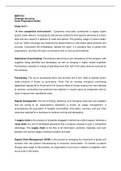Exam (elaborations)
The document answers questions at the end of each study unit in the study guide covering study units 1 to 8 and the answers provided are paraphrased for the prescribed textbook.
- Course
- Institution
- Book
The document answers questions at the end of each study unit in the study guide covering study units 1 to 8 and the answers provided are paraphrased for the prescribed textbook.
[Show more]




